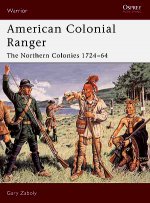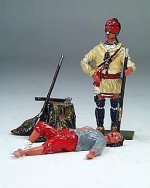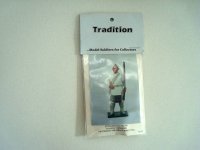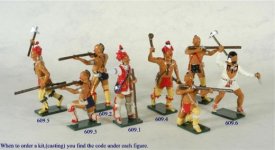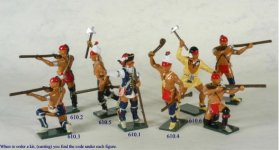RAMC
Here is one of the Osprey books that shows the Native Americans who were allied with the Rangers. They were Stockbridge Indians. Essentially tribes of the Iroquois Confederation were more apt to be allied with the British than the French, so Iroquois figures would work. Many of John's non-BOS Woodland Indians could be used as Iroquois and there is always Frontline's woodland Indian series.
"Stockbridge. A tribe of the Mahican confederacy, first known under the name Housatonic. They occupied part of the valley of Housatonic river, in south Berkshire county, Mass. Their principal village, Westenhuck, was for a long time the capital of the Mahican after the removal of the council fire from Schodac. They had another village at Skatehook. In 1734 Sergeant began missionary work among them, and two years later the several bands were collected on a tract reserved for their use by the Colonial government. After the village of Stockbridge was established they were known as Stockbridge Indians. The French and Indian war, which broke out in 1754, proved disastrous to the Stockbridge. Many of them joined the English army and their town suffered from marauding parties, so that at the close of the war there were only about 200 remaining. The whites were also closing in around them, and in 1785 the dispirited remnant, accepting an invitation of the Oneida, removed to a tract on Oneida creek in Madison and Oneida county, N. Y., where a new village sprang up. The removal required two years. Under the protection of the Oneida the Stockbridge again increased, and in 1796 numbered 300. In 1833, with the Oneida and Munsee, they removed to a tract at the head of Green bay, Wis., which had been purchased from the Menominee. Here they became incorporated with the Munsee, and the two tribes have since formed one body. From the time of their leaving New York the tribe has divided on questions in regard to land and citizenship. After interminable negotiations with the state and national governments the matter is still unsettled. In 1839 the Stockbridge and Munsee, then numbering about 420, sold half of their reservation and agreed to remove to lands that were to be assigned to them west of the Mississippi. On the remaining land a town was laid out, on the east shore of Winnebago lake, where it was intended to settle such as desired to become citizens. About 80 removed to the Missouri river and remained for a time near Leavenworth, Kans. The arrangement proved unsatisfactory, and they were once more brought together and the tribal government restored. In 1856 they removed, with the exception of a number who desired to become citizens, to a reservation west of Shawano, Shawano county, Wis., where in 1909 the united tribes, including the Munsee, numbered 582 souls. There are also some who have become citizens near their former home on Winnebago lake."


